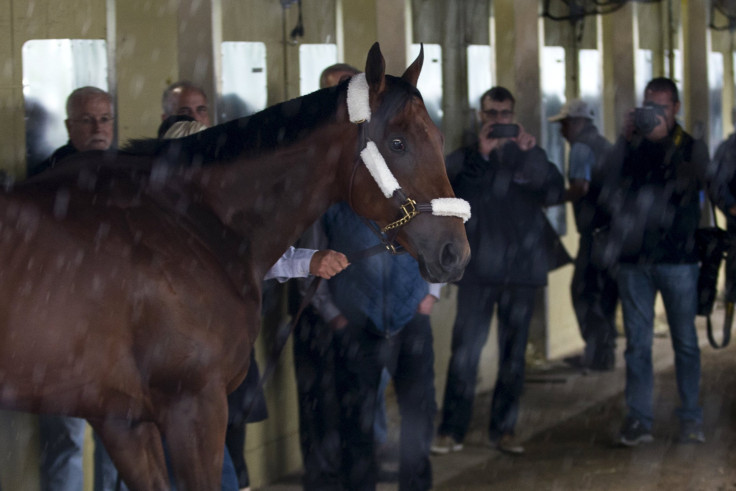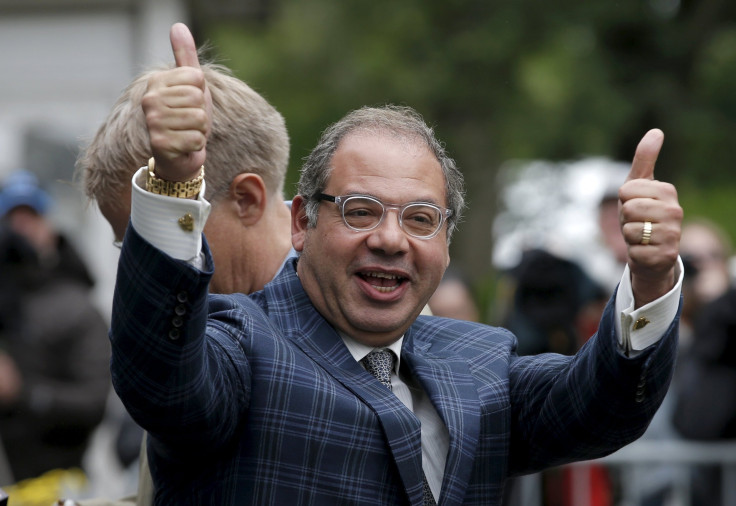American Pharoah Net Worth: How Much He Could Earn From Winning The Triple Crown

Even if he pulls off the first Triple Crown in 37 years, American Pharoah’s barely entered the back stretch of what could be a dominating career. Should the Pioneer of the Nile colt claim the 147th Belmont Stakes on Saturday in New York, horse racing and breeding experts believe American Pharoah could become a $75 million to $100-million stallion over the next five to six years.
Those major figures derive from American Pharoah’s pedigree, his overall racing career, and the potential talent his progeny displays once he’s retired from racing and put out to stud.
Victorious in his last six starts, including the Kentucky Derby and Preakness Stakes, and now the 14th contender for the Triple Crown in the last four decades, American Pharoah already made his owners Zayat Stables more than $3.7 million in winnings and could earn another $800,000 of the Belmont’s $1.5 million purse.
Should he beat out the eight other contenders in the Belmont field, American Pharoah will also bestow a kind of incalculable glory over stable owner Ahmed Zayat and trainer Bob Baffert, unseen since the last Triple Crown by Affirmed in 1978.
Then it’s likely on to the Breeders Cup Classic in October, with $2.75 million awarded to the winner. With five months of rest, American Pharoah’s winnings could make the already vastly wealthy Ahmed Zayat and his titular stable a windfall of more than $7.3 million, and stands to become the first horse to win all four of the sport’s major stakes races.
But from there, Zayat won’t see the lion’s share of American Pharoah’s stud fees. Zayat announced the sale of the bay-colored three-year-old’s breeding rights to the renowned Ireland-based breeding operation Coolmore Stud four days after his muddy seven-length Preakness victory.
It’s a very common deal in horse racing, with American Pharoah considered a prized stud as last year’s Champion Two-Year-Old well before he galloped around Churchill Downs and Pimlico. The terms of the deal weren’t disclosed, but Zayat stated he has control of American Pharoah’s racing career. It’s also believed in racing circles that Zayat is unlikely to race American Pharoah after the Breeders Cup in the fall. Once he’s retired, American Pharoah will stand, or breed, at Coolmore’s American subsidiary, Ashford Stud in Versailles, Kentucky.
Yet Coolmore Stud, which didn’t respond to interview requests, won’t fully know American Pharoah’s true value until he’s put out to stud. According to experts in the field, it could be five or six years until American Pharoah reaches his peak value.
The $100-million figure isn’t arbitrary or even unprecedented. American Pharoah could join the ranks of the country’s most renowned and proven sires, Tapit and War Front, on the lucrative stallion market.
Reiley McDonald, a managing partner with thoroughbred consignment and consulting firm Eaton Sales, said American Pharoah’s worth increased exponentially once he took the checkered flag at the Derby last month.
“From that point on, his value will also increase if he wins the Breeders Cup,” McDonald said. “So if he were to win all four of these going forward, he’s done his duty and now his value is worth significantly more as a stallion. If they stand him as a Triple Crown winner for $100,000 to $150,000 and breed 150 mares to him, and from that group gets 85 percent live foals.
“If you do the math, that’s significantly more than what he can make as a race horse during the season.”
McDonald, who helped the owners of 1977 Triple Crown winner Seattle Slew sell off the remainder of his bloodstock between 2002 to 2003, also said it’s in Coolmore’s best interests if American Pharoah never races as a four-year-old.
“Let’s again assume he has won the Triple Crown and or races after that. If his career were to turn as a four-year-old, and he were not to be quite as successful, well it’s not that he’s any less of a horse,” McDonald said.
“However, the bloom is somewhat off the rose at that point.
“So there’s probably more downside to racing him as a four-year-old than there would be any form of upside, based on the fact that if he wins either one of the next two big races, the Belmont or the Breeders Cup, his value has pretty much peaked at that point as a stallion.”
Even if American Pharoah falters at the Belmont, a possible scenario given the extra quarter-mile he must run on only three weeks rest since the Preakness, his value might not slip too much because of his pedigree. Eaton said a rich pedigree is on American Pharoah’s side, unlike last year’s near Triple Crown-winner California Chrome, who shot to fame based off his $10,000 sale price and blew away competition with much stronger lineages.
American Pharoah’s aforementioned sire Pioneer of the Nile won the Grade 2 San Felipe Stakes, the Grade 1 Santa Anita Derby, and was runner-up at the 2009 Kentucky Derby. With all five of his career victories coming in races 1 1/16-miles or longer, Pioneer of the Nile passed his build for speed over long distances on to American Pharoah and five of his other foals have all won a stakes race at a mile or longer, according to Daily Racing Form. Going further back, American Pharoah’s ancestry includes 2003 Derby runner-up and Belmont-winner Empire Maker, as well as 1990 Derby and Breeders Cup champion Unbridled.
McDonald used the exorbitant six-figure stud fee only as an example of what Coolmore might be able to demand for American Pharoah, saying there’s really no comparison for him in the United States. The closest juxtaposition for American Pharoah in Europe could be the undefeated and since-retired Frankel, owned by Saudi Prince Khalid Abdullah and stood at his Juddmonte Farms for as much as $200,000.
McDonald stressed that as of now American Pharoah may fetch $100,000, but as a Triple Crown winner his stud fee may balloon to $150,000 or more.
One tricky aspect to charging such a massive stud fee is pairing American Pharoah with the best mares. Owners of mares could potentially shy away, and thus American Pharoah’s offspring could suffer and his overall value as a stud will slide.
Ashford, one of the biggest breeders in the country, is likely to build up its investment in American Pharoah by breeding him with its own good mares to get him started, according to McDonald.
“At the end of the day, the real money in these horses is when they become proven stallions, [which] have offspring that are running in the top races. People then pay multiples of the starting fee when they started off the race track,” McDonald said.

According to veteran bloodstock agent Tom Clark, owner of his self-titled bloodstock firm, more could be made from American Pharoah’s stud fees than what’s originally been reported. He stressed there’s a wide gap between the reported stud fee and the one negotiated on the open market.
For example, Clark said War Front, stood by Claiborne Farm in Paris, Kentucky, is advertised at $150,000, but on the open market and depending on the season the fee could reach into the $250,000 to $300,000 stratosphere. This past season, Clark said he knows for a fact War Front stood for $300,000.
When you consider the average lifespan of a horse is between 25 to 30 years, over time the figures being thrown around American Pharoah could reach astronomical heights, and it begs the question: Why would Zayat sell the breeding rights so early, if at all?
The answer, Clark believes, is that Zayat would not have made the deal with Coolmore and Ashford unless he retained at least a significant stake in American Pharoah. Clark also said that some believe the deal was struck as early as December, before American Pharoah raced this year but after he was dubbed Champion Two-Year-Old.
“The way that would have worked is Zayat would have retained a significant portion of the horse. It’s his modus operandi to do that,” Clark said. “Industry insiders knew it was done before it was announced after [the Preakness] and the reason is that a lot of the major farms knew they couldn’t get the deal done.”
We may never know the complete framework of the Coolmore-Ashford-Zayat deal. However, Zayat told paulickreport.com the deal includes “incentives” or “kickers” that would increase the total amount for every race American Pharoah won, including the completion of the Triple Crown.
“Zayat would never have done that deal prior to the Kentucky Derby without those kickers,” Clark said. “To make the deal in December turned out to be quite smart.”
Even before stud fees, Clark estimated American Pharoah to be worth $50 million today, an amount that might grow to $65 million should he prevail at the Belmont and Breeders Cup. Clark bases those figures on horse racing’s syndication system, which offers shares to potential investors. Today, a single share in Tapit or War Front would run roughly $2.5 million, leading to their estimated net value of $100 million.
Yet, one of the key points here is just because a horse won the Triple Crown, doesn’t mean he’ll necessarily throw his skills to his offspring. McDonald pointed to Secretariat as an example of an all-time great who went for record fees as a first-year stud but largely failed to pass along his once-in-a-lifetime traits. Seattle Slew on the other hand exceeded expectations during his racing career and passed his considerable skills on to become one of the best stallions in the country.
American Pharoah might garner offers of $150,000 to $175,000 starting off as a stud, but prospective owners won’t continue to shell out a fee that high unless his progeny prove successful on the track. It's something we might not know as late as 2020 or 2021, after a couple of crops have panned out.
Half a decade from now is a long time, and Coolmore and Zayat are likely fixed on the Belmont for now. It’s the one place American Pharoah can firmly cement the first-half of his legacy.
“We all know he’s the real deal,” Clark said. “What he looks like is a Seattle Slew-level performer. He’s not an ordinary good horse.”
© Copyright IBTimes 2025. All rights reserved.





















